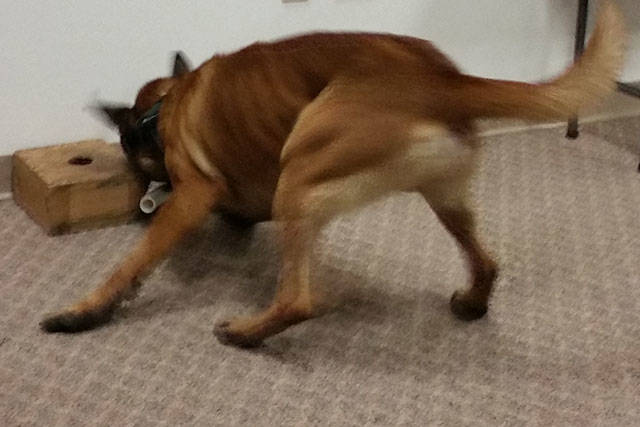MARYSVILLE – Their bites are worse than their barks.
That’s why it’s up to their handlers to make sure their police dogs respond on command.
“We have to make sure the bad guys are safe,” K-9 Officer Derek Oakes said.
The Marysville Police Department’s newest K-9s – Copper and Steele – were just last week certified to search for narcotics. A few weeks earlier they were certified to track people.
The Marysville Police Citizens Academy recently met the dogs and their trainers – Brad Smith for Steele and Oakes for Copper.
The handlers acted like they were dog tired after training the animals for hundreds of hours over more than six months.
“We spend more time with the dogs than our families,” Oakes said.
The dogs are trained so they always win because they can’t have any fear.
“In their minds they are the biggest, toughest police dogs ever,” Oakes said.
Another K-9 officer, Stacey Dreyer, added, “There are officers in our department who are scared to death of our dogs.”
Even though the dogs have bullet-proof vests, their handlers said they probably never will wear them.
“They don’t understand life and death,” Oakes said, adding he won’t send a dog in if he knows a suspect is armed.
Despite all the training, the officers said they really don’t know if their dogs will be successful until after their first mission.
“They aren’t lusting after blood,” Oakes said. “Our dogs just don’t bite people.”
Smith said any dog can be trained to be a drug dog. But MPD gets top-quality dogs.
“We want that bloodline for insurance reasons,” Dreyer said. “It’s a bigger liability if it’s not a top breed. The best bloodlines are on the other side of the pond” in Europe.
Dreyer started the MPD K-9 unit in 1999. The city had no money for it so he raised $36,000 in donations to buy two. Since the dogs usually work for about eight years, the city is now on dogs seven and eight. Previous dogs were basically for a single purpose. Ranger and Radar were patrol dogs “to find the bad guys” while Brody and Katie were narcotics dogs.
Dogs can be trained in three other disciplines: search and rescue, cadaver and bomb.
Dual training makes sense for some disciplines but not others. Such as you wouldn’t want an aggressive dog that tracks criminals trying to learn search and rescue, too.
Patrol dogs are only used on major felonies and violent crimes like robbery, assault and domestic violence. “It’s a narrow scope of deployment,” Oakes said.
Sometimes officers might bring them out on other calls, however, because their bark can frighten people, and they also can be a visual deterent.
One dog, Katie, had to be retired when pot was legalized in this state. “A dog’s smell is one-hundred thousand times better than a person’s” Oakes said. “I don’t think you can train them NOT to find marijuana.”
After pot was legalized, drug arrests dropped from 200 to 60 a year. Now the dogs are trained to find meth, heroin and cocaine.
The trainers make a game out of finding the drugs. “We train with the actual drug odor,” Oakes said.
It’s placed in a PVC pipe, and they play fetch with it. “It’s the best toy in the world,” Oakes said.
Then they hide it, and ‘find it for dad,” he added. “It’s the best game of hide and seek ever.”
The dogs are work dogs, not pets, at least until they retire. They are kept in kennels.
“Work needs to be fun. We want them excited out of their minds” to go to work, Dreyer said.
He told a humbling tale about how police were searching for a suspect in the woods, when he commanded Ranger to be still. After some time they began to search again. Ranger went about 7 feet away from Dreyer to catch the suspect.
Dreyer joked that Ranger probably was thinking, “If I could drive I could leave this guy at home.”
Now that Ranger is retired, he’s getting back at Dreyer.
“Ranger thinks, ‘I don’t need to listen to anybody now,’ ” Dreyer said.


